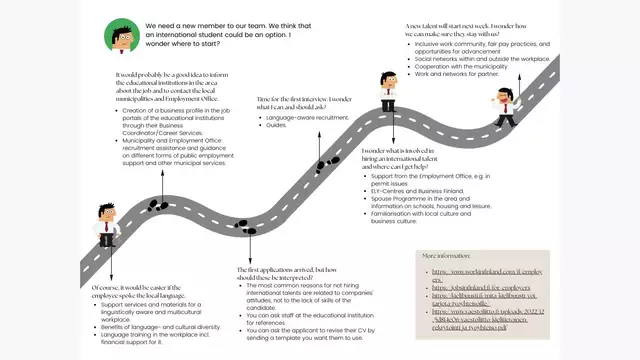Fast Expert Teams as a method for addressing the complex issue of retaining international students in Finland
Published: 29.05.2023 / Blog / Publication
Attracting and retaining international students and graduates is a national priority in Finland. It is a complex issue requiring collaboration between multiple stakeholders nationally and regionally. The Fast Expert Teams (FET) method has been used for this purpose and this blog post expresses the results of one of the sub-teams working on this issue in the beginning of 2023. We will begin by describing the problem we aimed to solve and then explain the FET process and how we used it in this context. We then present the key characteristics, and discuss the outcomes, of our sub-team’s process.
The challenge
In this particular FET process, we were asked to look for solutions, ideas, and new perspectives on how to retain international students in Finland. The process was commissioned by the Finnish Growth Corridor, which is a regional development cooperation network from Helsinki to Seinäjoki, formed in 2013.
This same challenge is also addressed at the national level by the Talent Boost programme for attracting and retaining international talent in Finland in order to compensate for the diminishing workforce. The programme involves many stakeholders, such as government, municipalities, higher education institutions (HEIs), employment offices, regional development actors, labour market organisations, and companies.
What is the FET-process?
The FET approach was developed in Finland during the Covid-19 pandemic as an initiative of LUT University. The aim was to prevent Finland from paralysis during the pandemic, by enabling multiple stakeholders to solve problems together online. The Institute of Occupational Health coordinated the results of the FET processes and shared them with the Finnish working life. FET work is always focused on a theme or task and is solution-oriented. As the name suggests, the work is fast-paced and takes place in teams, fully digitally, over a period of about four weeks. The teams work on solutions to a specific part of a task or challenge. Increasingly, solving challenges and complex tasks requires combining different types of knowledge and expertise. Working across sectoral and professional boundaries broadens the perspective and reduces the risk of looking at a task in too narrow or traditional ways.
FET sub-team for work culture
As the retention of international students in Finland is highly dependent on local employment, it is crucial to enable the recruitment and retention of international students in Finnish workplaces. We worked on this challenge in a sub-team focusing specifically on work culture in Finnish companies. We chose to focus on Finnish small- and medium sized enterprises (SMEs) as these in 2021 comprised 99,9% of all companies in the private sector (Tilastokeskus, n.d.). However, 96,6% of the SMEs in Finland were actually micro and small enterprises (MSEs) with only 0-9 employees (Tilastokeskus, n.d.). Many of these companies are finding it difficult to attract and retain international talent because they do not have the time or resources to adapt their processes and culture to the new competitive market due to labour shortages. They may therefore need more support from external actors if they lack human resources or recruitment skills. But while ability to do something can be learned, willingness has to come from the inside. We therefore chose to focus our attention on companies who might be willing, but not have the ability, to employ international students, and explore potential solutions to enhance their ability through external stakeholder support. We decided to create a dream path to recruiting international talents for companies with a "I would hire if I knew how to" attitude.
Four characteristics of a dream path
Our dream path for employers contains steps to take, and the support offered, along the path, based on the four characteristics below:
Employability and employer-ability
There is much debate about the employability of international students and whether HEIs prepare them sufficiently for employment. Interestingly, the responsibility for employability seems to lie with HEIs (curricula and career support) and individual students (knowledge, skills, attitudes, networks, etc.). However, the responsibility of employers is largely absent from the debate and literature. The term ‘employer-ability’ was introduced by Morely (2001) and mentioned by Moreau and Leathwood (2006) as well as by Sultana (2022) but has never been defined. How can external stakeholders support companies that are willing - but not able - to employ international students and graduates?
The importance of inclusive corporate culture
When considering hiring international and culturally diverse people, it is important to understand diversity, equality, and inclusion (DEI) to ensure that all employees feel valued and that they belong in the workplace. Workplaces can easily be diverse but not inclusive or equal. Different cultures, languages, experience levels, and customs affect companies, so training and mutual understanding are key to capitalising on the strengths of a diverse workforce. To ensure sustainability, corporate culture plays a major role in providing the sense of belonging, support, and appreciation employees need. Looking beyond the company, we can see how society also plays an integral part in the success of culturally diverse businesses, with support and regulations depending on external factors. Corporate Social Responsibility (CSR) means that companies are socially responsible to all stakeholders (Tantalo et al., 2012). (Djebarni & Ebie, 2010; Erwee, 2004)
Overcoming barriers with the help of others
Bringing in people from different backgrounds and cultures can bring fresh ideas and perspectives to a company, stimulating innovation and creativity. On the other hand, language barriers or cultural differences can hamper communication and integration. SMEs can face a number of potential barriers when recruiting international talent. The most common barriers are language skills, cultural differences, visa and work permit requirements, lack of knowledge of laws and regulations, recruitment costs, lack of recruitment skills, lack of time and perceived difficulties, for example in the use of English. Support from external stakeholders can help with recruitment challenges and enable solutions by sharing resources, knowledge, and skills to improve the recruitment and retention processes. (Cheng et al., 2022; Tran & Soejatminah, 2017)
Local support
For SMEs it is important to have good networks locally and e.g. municipalities play a key role in promoting employment opportunities and improving the recruitment capacity of businesses in the regions. In the recruitment of international talent in the private sector, municipalities act primarily as removers of barriers and as creators of a positive, open, and welcoming atmosphere in the local society. However, through procurement, municipalities also have the opportunity at an operational level to promote the employment of international talent.
The member organisations of the regional Centres for Economic Development, Transport, and the Environment (ELY Centers) offer various incentives and services to reduce bottlenecks by increasing the skills in the company for acquiring e.g. international talent. The ELY Centres and municipalities are also responsible for social integration in the regions where they cooperate with employment offices, associations, and companies.
Local HEIs are great resources for employers to recruit international talent and for upskilling and reskilling their current staff through continuous learning. The attraction and retention of international students in Finnish HEIs are in turn highly connected to local employment during and after studies (Juusola et al., 2021). Additionally, international student attraction and retention depends on social integration in society (Juusola et al., 2021). This calls for local collaboration around education, employment, and social integration.
"I would hire if I knew how to" – the employers’ dream path to recruiting international students
The outcome of our sub-team’s FET process was the illustrated dream path for employers to recruit international students. The quote is fictional, but written with hands-on experience, to show how to potentially overcome barriers to the recruitment of international students in an SME.
Could we hire an international student? I couldn't do it myself with my lack of English skills, but I delegated the job. Fortunately, Matti took responsibility for this. We got in touch with the local higher education institution and were invited to campus to present our company. A few international students got interested and we even managed to arrange interviews during the same visit. Matti and I went through the interviews and we found the right student. At this point we asked the Employment Office for help around what we should consider when hiring an international student. We sorted things out together and the employment contract was signed.
There were some practical issues to solve, but we managed to arrange them. We agreed with the whole company that we would take care of the student. Everyone who wants to and dares to, would be a so-called host for a week. It went really well and they went fishing, played football, and went on excursions in the area. It must have been nice for the student not to have to sit in a flat alone in the evenings after work. Almost everyone in the company said that if this student doesn't come to us again next summer, we'll get someone else. But preferably this one. Support for hiring an international student is available and if we could do it, so could you.
In conclusion, we believe that rethinking the notion of employment depending only on sufficient employability of the international student, and instead also considering the willingness and ability of local employers to attract and retain them, would enable better retention of these students in Finland.

The hiring company's dream path towards a more diverse and inclusive company culture. Picture: Hanna Ikonen.
Edited by:
Sandra Slotte, Senior Policy Advisor, Internationalisation, Arcada University of Applied Sciences
Authors:
Hanna Ikonen, Work Community Developer, Work Style- and Cultural Designer, Resis Oy / Rakka Works
Ella Muja, student at TAMK Proakatemia
Sandra Slotte, Senior Policy Advisor, Internationalisation, Arcada University of Applied Sciences
Laura Ojanen, Project Coordinator, City of Tampere Employment and Growth Services
Tuomo Kauha, Team Finland Coordinator, Centre for Economic Development, Transport and the Environment in Häme
Anna-Mari Sopenlehto-Jokinen, Specialist, city of Turku, Central Administration
Ari Hänninen, Innovator
References
Cheng, M., Adekola, O., Albia, J., & Cai, S. (2022). Employability in higher education: A review of key stakeholders’ perspectives. Higher Education Evaluation and Development, 16(1), 16–31. https://doi.org/10.1108/HEED-03-2021-00…
Djebarni, R., & Ebie, S. (2010). Equality and Diversity Management: An Investigation into the Business Case of Equality and Diversity Practice in SMEs. The International Journal of Diversity in Organizations, Communities, and Nations: Annual Review, 10, 145–168. https://doi.org/10.18848/1447-9532/CGP/…
Erwee, R. (2004). Integrating diversity management initiatives with strategic human resource management. In R. Wiesner & B. Millett (Eds.), Human Resource Management: Challenges and Future Directions (pp. 57–71). John Wiley & Sons, Ltd.
Juusola, H., Nori, H., Lyytinen, A., & Kivistö, J. (2021). Ulkomaiset tutkinto-opiskelijat suomalaisissa korkeakouluissa. Miksi Suomeen on päädytty ja kiinnostaako työskentely Suomessa opintojen jälkeen? Eurostudent VII -tutkimuksen artikkelisarja (No. 14; p. 41). Opetus- ja kulttuuriministeriö. https://julkaisut.valtioneuvosto.fi/bit…
Moreau, M.-P., & Leathwood, C. (2006). Graduates’ Employment and the Discourse of Employability: A Critical Analysis. Journal of Education and Work, 19(4), 305–324. https://doi.org/10.1080/136390806008670…
Morley, L. (2001). Producing New Workers: Quality, Equality and Employability in Higher Education. Quality in Higher Education, 7(2), 131–138. https://doi.org/10.1080/135383201200600…
Sultana, R. G. (2022). Four ‘dirty words’ in career guidance: From common sense to good sense. International Journal for Educational and Vocational Guidance. https://doi.org/10.1007/s10775-022-0955…
Tantalo, C., Caroli, M., & Vanevenhoven, J. (2012). Corporate social responsibility and SME’s competitiveness. International Journal of Technology Management, 58(1/2), 129–151. https://doi.org/10.1504/IJTM.2012.045792
Tilastokeskus. (n.d.). Yritykset. Tilastokeskus. Retrieved November 28, 2022, from https://www.tilastokeskus.fi/tup/suoluk…
Tran, L. T., & Soejatminah, S. (2017). Integration of Work Experience and Learning for International Students: From Harmony to Inequality. Journal of Studies in International Education, 21(3), 261–277. https://doi.org/10.1177/1028315316687012


